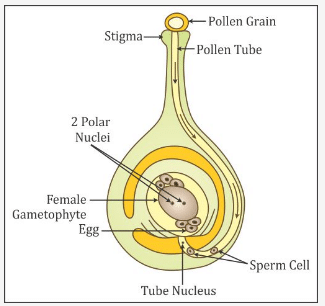Class 7 Exam > Class 7 Questions > How does fertilization occur in flowering pla...
Start Learning for Free
How does fertilization occur in flowering plants?
Verified Answer
How does fertilization occur in flowering plants?
Fertilization in plants: In plants, pollination is followed by fertilization. Once the pollen grains are deposited on the stigma, it forms the pollen tube. The pollen tube grow through the ovules and reach the ovary where the egg cell is located. The pollen tube normally enters the ovule through a small opening called micropyle. Inside the ovule, the pollen tube releases two male gametes into the embryo sac.


 This question is part of UPSC exam. View all Class 7 courses
This question is part of UPSC exam. View all Class 7 courses
Most Upvoted Answer
How does fertilization occur in flowering plants?
Fertilization in flowering plants is a complex process that involves the fusion of male and female gametes. It occurs within the reproductive structures of the flower, specifically in the ovary, where the female gametes are located. Let's explore this process in detail:
The Structure of a Flower
Flowers are the reproductive organs of flowering plants. They consist of several parts, including the stamen (male reproductive organ) and the pistil (female reproductive organ). The pistil is composed of three main parts: the stigma, the style, and the ovary. The stigma is the receptive surface that receives the pollen, while the style connects the stigma to the ovary.
Pollen Production and Transfer
The stamen produces pollen, which contains the male gametes. Each pollen grain consists of a generative cell (develops into sperm) and a tube cell (forms a pollen tube). Pollen transfer occurs through various mechanisms, such as wind, water, or insect pollination. In insect-pollinated flowers, the pollen is often transferred from the anther (part of the stamen) to the stigma of the same flower or another flower of the same species.
Pollen Germination
Once the pollen lands on the stigma, it undergoes germination. The tube cell of the pollen grain extends as a pollen tube, growing down through the style towards the ovary. The generative cell travels within the pollen tube towards the ovary.
Fertilization Process
The ovary contains one or more ovules, each of which contains a female gamete called an egg cell. The pollen tube penetrates the ovary and enters the ovule through a small opening called the micropyle. The generative cell then divides to form two sperm cells.
Double Fertilization
Double fertilization is a unique feature of flowering plants. It involves the fusion of two sperm cells with two different cells in the ovule. One sperm cell fuses with the egg cell, resulting in the formation of a zygote (the fertilized egg). This zygote develops into an embryo, which forms the future plant. The other sperm cell fuses with two polar nuclei in the ovule, resulting in the formation of endosperm. The endosperm serves as a nutrient-rich tissue that nourishes the developing embryo.
Seed Development
After fertilization, the ovule develops into a seed. The ovary surrounding the ovule enlarges and forms a fruit, which protects the seed. The seed contains the embryo, endosperm, and a protective seed coat. It is dispersed from the parent plant and, under favorable conditions, germinates to give rise to a new plant.
In conclusion, fertilization in flowering plants involves the transfer of pollen to the stigma, followed by pollen germination, pollen tube growth, and the fusion of male and female gametes. This process leads to the formation of a zygote and endosperm, ultimately resulting in seed development and the production of new plants.
The Structure of a Flower
Flowers are the reproductive organs of flowering plants. They consist of several parts, including the stamen (male reproductive organ) and the pistil (female reproductive organ). The pistil is composed of three main parts: the stigma, the style, and the ovary. The stigma is the receptive surface that receives the pollen, while the style connects the stigma to the ovary.
Pollen Production and Transfer
The stamen produces pollen, which contains the male gametes. Each pollen grain consists of a generative cell (develops into sperm) and a tube cell (forms a pollen tube). Pollen transfer occurs through various mechanisms, such as wind, water, or insect pollination. In insect-pollinated flowers, the pollen is often transferred from the anther (part of the stamen) to the stigma of the same flower or another flower of the same species.
Pollen Germination
Once the pollen lands on the stigma, it undergoes germination. The tube cell of the pollen grain extends as a pollen tube, growing down through the style towards the ovary. The generative cell travels within the pollen tube towards the ovary.
Fertilization Process
The ovary contains one or more ovules, each of which contains a female gamete called an egg cell. The pollen tube penetrates the ovary and enters the ovule through a small opening called the micropyle. The generative cell then divides to form two sperm cells.
Double Fertilization
Double fertilization is a unique feature of flowering plants. It involves the fusion of two sperm cells with two different cells in the ovule. One sperm cell fuses with the egg cell, resulting in the formation of a zygote (the fertilized egg). This zygote develops into an embryo, which forms the future plant. The other sperm cell fuses with two polar nuclei in the ovule, resulting in the formation of endosperm. The endosperm serves as a nutrient-rich tissue that nourishes the developing embryo.
Seed Development
After fertilization, the ovule develops into a seed. The ovary surrounding the ovule enlarges and forms a fruit, which protects the seed. The seed contains the embryo, endosperm, and a protective seed coat. It is dispersed from the parent plant and, under favorable conditions, germinates to give rise to a new plant.
In conclusion, fertilization in flowering plants involves the transfer of pollen to the stigma, followed by pollen germination, pollen tube growth, and the fusion of male and female gametes. This process leads to the formation of a zygote and endosperm, ultimately resulting in seed development and the production of new plants.
Community Answer
How does fertilization occur in flowering plants?
When pollen grains are transfered from the d anther to d stigma pollination do takes place which is then responsible for fertilisation ovule - seed ovary- fruit
Attention Class 7 Students!
To make sure you are not studying endlessly, EduRev has designed Class 7 study material, with Structured Courses, Videos, & Test Series. Plus get personalized analysis, doubt solving and improvement plans to achieve a great score in Class 7.

|
Explore Courses for Class 7 exam
|

|
Similar Class 7 Doubts
How does fertilization occur in flowering plants?
Question Description
How does fertilization occur in flowering plants? for Class 7 2024 is part of Class 7 preparation. The Question and answers have been prepared according to the Class 7 exam syllabus. Information about How does fertilization occur in flowering plants? covers all topics & solutions for Class 7 2024 Exam. Find important definitions, questions, meanings, examples, exercises and tests below for How does fertilization occur in flowering plants?.
How does fertilization occur in flowering plants? for Class 7 2024 is part of Class 7 preparation. The Question and answers have been prepared according to the Class 7 exam syllabus. Information about How does fertilization occur in flowering plants? covers all topics & solutions for Class 7 2024 Exam. Find important definitions, questions, meanings, examples, exercises and tests below for How does fertilization occur in flowering plants?.
Solutions for How does fertilization occur in flowering plants? in English & in Hindi are available as part of our courses for Class 7.
Download more important topics, notes, lectures and mock test series for Class 7 Exam by signing up for free.
Here you can find the meaning of How does fertilization occur in flowering plants? defined & explained in the simplest way possible. Besides giving the explanation of
How does fertilization occur in flowering plants?, a detailed solution for How does fertilization occur in flowering plants? has been provided alongside types of How does fertilization occur in flowering plants? theory, EduRev gives you an
ample number of questions to practice How does fertilization occur in flowering plants? tests, examples and also practice Class 7 tests.

|
Explore Courses for Class 7 exam
|

|
Suggested Free Tests
Signup for Free!
Signup to see your scores go up within 7 days! Learn & Practice with 1000+ FREE Notes, Videos & Tests.

























